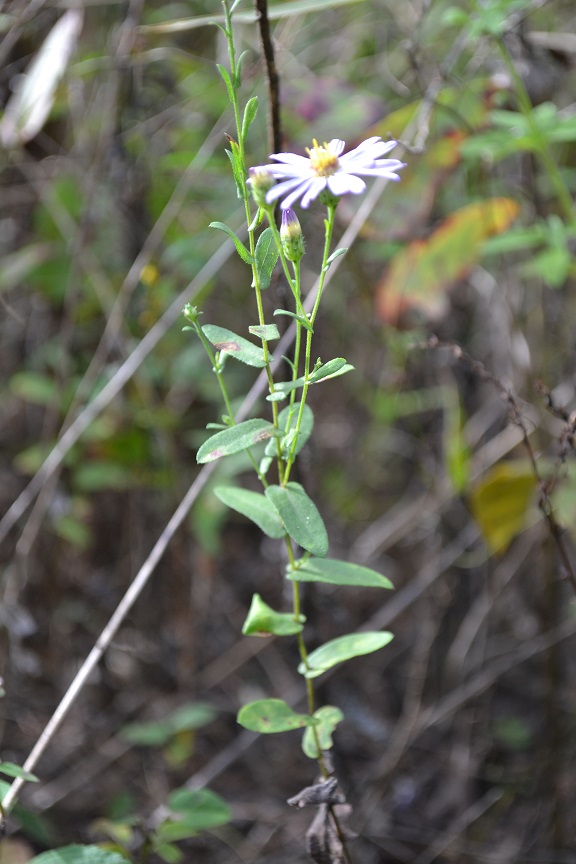Difference between revisions of "Symphyotrichum patens"
Krobertson (talk | contribs) |
Krobertson (talk | contribs) |
||
| Line 41: | Line 41: | ||
===Fire ecology=== <!--Fire tolerance, fire dependence, adaptive fire responses--> | ===Fire ecology=== <!--Fire tolerance, fire dependence, adaptive fire responses--> | ||
| − | Burton found that the percent cover of S. patens showed a positive linear response to increased fire frequency. <ref name="Burton 2009"/> | + | Burton found that the percent cover of S. patens showed a positive linear response to increased fire frequency.<ref name="Burton 2009"/> |
<!--===Pollination===--> | <!--===Pollination===--> | ||
<!--===Use by animals===--> <!--Herbivory, granivory, insect hosting, etc.--> | <!--===Use by animals===--> <!--Herbivory, granivory, insect hosting, etc.--> | ||
<!--===Diseases and parasites===--> | <!--===Diseases and parasites===--> | ||
| + | |||
==Conservation and management== | ==Conservation and management== | ||
==Cultivation and restoration== | ==Cultivation and restoration== | ||
Revision as of 23:28, 19 November 2019
| Symphyotrichum patens | |
|---|---|

| |
| Photo by Kevin Robertson | |
| Scientific classification | |
| Kingdom: | Plantae |
| Division: | Magnoliophyta – Flowering plants |
| Class: | Magnoliopsida – Dicotyledons |
| Order: | Asterales |
| Family: | Asteraceae ⁄ Compositae |
| Genus: | Symphyotrichum |
| Species: | S. patens |
| Binomial name | |
| Symphyotrichum patens (Aiton) G.L. Nesom | |

| |
| Natural range of Symphyotrichum patens from USDA NRCS Plants Database. | |
Common names: Late purple aster, Spreading aster
Contents
Taxonomic notes
Synonyms: Aster patens Aiton var. patens; Virgulus patens (Aiton) Reveal & Keener var. patens; A. patens var. gracilis Hooker
Varieties: Symphyotrichum patens (Aiton) G.L. Nesom var. patens; Symphyotrichum patens (Aiton) G.L. Nesom var. gracile (Hooker) G.L. Nesom; Symphyotrichum patens (Aiton) G.L. Nesom var. patentissimum (Lindley ex A.P. de Candolle) G.L. Nesom; Symphyotrichum patens (Aiton) G.L. Nesom var. terranigrum J.J.N. Campbell & Seymour
Description
A description of Symphyotrichum patens is provided in The Flora of North America.
Distribution
Ecology
Habitat
This species can live in humid, subtropical climates in drying sandy loam on the edges of woodland remnants, shade of mesic woodlands, xeric limestone prairies, open old-field pine woods, and sandy clay of the Red Hills.[1][2][3] It can live in communities dominated by post oak as well.[1]
Phenology
S. patens has been observed flowering in January, March through May, October, and November and fruiting between October and November.[2][4]
Fire ecology
Burton found that the percent cover of S. patens showed a positive linear response to increased fire frequency.[1]
Conservation and management
Cultivation and restoration
Photo Gallery
References and notes
- ↑ 1.0 1.1 1.2 Burton, J. A. (2009). Fire frequency effects on vegetation of an upland old growth forest in eastern Oklahoma. Environmental Science. Stillwater, Oklahoma, Oklahoma State University. Bachelor: 78.
- ↑ 2.0 2.1 Florida State University Robert K. Godfrey Herbarium database. URL:http://herbarium.bio.fsu.edu. Last accessed: June 2014. Collectors: Loran C. Anderson, Angus Gholson Jr., R. Kral, Robert K. Godfrey, Angela M. Reid, K. M. Robertson, Ann F. Johnson, and Wilson Baker. States and Counties: Florida: Gadsden and Leon.
- ↑ McClain, W. E. and J. E. Ebinger (2014). "Vascular Flora of Buettner Xeric Limestone Prairies, Monroe County, Illinois." Southern Appalachian Botanical Society.
- ↑ Nelson, G. PanFlora: Plant data for the eastern United States with emphasis on the Southeastern Coastal Plains, Florida, and the Florida Panhandle. www.gilnelson.com/PanFlora/ Accessed: 14 DEC 2016